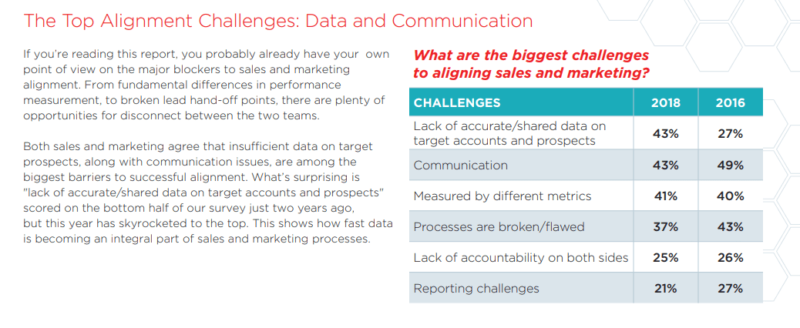 It’s no secret that marketing and sales don’t always see eye to eye.
It’s no secret that marketing and sales don’t always see eye to eye.
The sales team gets mad at the marketing team for lack of leads and marketing gets mad at sales for not closing deals.
For two areas so closely tied to one another, the lack of cooperation is pretty amazing.
In fact, according to a recent study from InsideView titled, “The State of Sales and Marketing Alignment in 2018,” only 37 percent of salespeople reported meeting with marketing to discuss lead scoring.

Even more telling, Hubspot’s State of Inbound 2017 report noted only 44 percent of marketers feel they are aligned with sales. Yikes!

Breaking down silos isn’t simple, and it certainly isn’t a new concept. We’ve been talking about this for years, and while technology has made it much easier for sales and marketing to align, many companies still treat these departments separately.
How can we better align our sales and marketing efforts, specifically when it comes to search engine optimization (SEO)?
Obviously, there isn’t one answer, and for each organization it will be different. However, when thinking about SEO and sales, there are a few things we can do:
1. Set up monthly integrated meetings
When I worked in-house, the marketing team held weekly calls with the support team. The goal was to discuss common issues facing customers, identify problems or gaps on the site and ensure the marketing and support team were aligned with communication.
The same thing can apply to sales and marketing.
Set up monthly meetings to discuss goals, strategies, results and campaigns. The key to being successful is ensuring everyone knows what is happening, why it’s happening and how to address it. I can’t tell you how many times I’ve seen a marketing team launch a campaign without telling the sales team. How are they supposed to sell something they don’t know anything about?
Consider creating a Slack channel for the teams to communicate. Open lines of communication and shared knowledge equate to a more cohesive team.
2. Use sales data to inform SEO tactics
When we bring a new client on board, we spend a considerable amount of time talking through the sales process, evaluating existing sales materials, and in many cases, sitting through product demos and sales pitch decks.
We ask questions like:
- Who is the target buyer?
- Who is the decision-maker?
- What are key issues you hear during the sales process?
While these questions may seem basic, they help determine how and where buyers search and what type of content we need to give them.
For example, if a client only sells to companies with over $100 million in revenue, addressing the challenges facing small business doesn’t make any sense. If the Chief Financial Officer (CFO) is the decision-maker, their main concern is likely tied to how your product or solution will help them financially.
Understanding the nuances of the buyer, the sales process and everything that comes with it is key to creating an SEO strategy that helps drive sales — which leads us perfectly into our next point.
3. Map your keywords to the customer journey
What is the goal of an SEO program? To be found by the right people, at the right time, in search results. More or less.
Easier said than done. We need not only to understand the buyer but also to understand the keywords our buyers are using and the search intent behind them throughout the entire customer journey.
That feels like a lot!
Fortunately for us, the data found in the material used to bring on a new client, the sales process, the pitch deck and common problems can help form the keyword research process.
A keyword research process must also adapt. It has to focus on themes and intent and can no longer be about selecting a few phrases and calling it a day.
Once you have your keyword themes, you can review with your sales team, start mapping them to the customer journey, and more importantly, begin applying them to the overall content and SEO strategy.
4. Create assets that work for everyone
As an SEO, you typically have firsthand knowledge of what content is needed, what content is being created and where that content lives. That isn’t the case for every department.
A few days ago, a client mentioned she found a bunch of really great content on the site that wasn’t linked from anywhere and was only being used for sales. The marketing team didn’t know about it, and we didn’t know about it. What could we do with it?
Understanding what is out there and how it can be used across marketing and sales can be beneficial to your overall strategy.
Let’s take webinars, for example. Most companies hold a webinar, and then you never hear about it again. But what if we took that webinar and used it across departments? What if we took that one piece of content and turned it into several? We could have:
- A blog post summarizing the webinar which can be optimized for search, shared across social and sent out to everyone who registered for the webinar to re-engage them.
- Short clips from the webinar which can be shared on YouTube, added into the blog post and embedded into landing pages for the sales team to utilize.
When creating assets, we have to think beyond search and consider how we can create something that benefits the organization as a whole.
5. Use SEO data to inform sales
We already talked about using sales data to inform your SEO strategy, but it also works the other way around.
As SEOs, we spend a lot of time in analytics working to understand how our site is performing, what our visitors like, what they don’t like and where we can improve. We also spend a lot of time looking at search results and competitors.
How much of that are you sharing with your sales team?
During the monthly meeting I mentioned above, make sure your sales team is aware of the following:
- Top-performing content themes. They don’t have to know the exact pieces of content, but if specific areas are resonating with visitors, they can push that topic during calls or share the materials with prospects.
- Competitor updates or campaigns. Very few people are looking at one solution and one solution alone. They are also looking at your competitors. The team should be aware of how competitors are performing, the type of messaging they are using and any other updates coming from them.
- Customer reviews or complaints. What are people saying about you on the internet? What are the positives and the negatives? By sharing these with the sales team, they can proactively address potential concerns and promote positive reviews.
Sharing information between departments will go a long way in helping the organization. While the three bullets mentioned above may not seem significant to your efforts, they could be to someone else’s.
Tying it all together
Aligning efforts across the organization, specifically between SEO and sales, can make both teams better and drive growth faster. It may not be easy to get a process in place, but if you start with communication, the rest will follow.
The post How to align SEO and sales teams so everyone benefits appeared first on Search Engine Land.
from SEO Rank Video Blog https://ift.tt/2EwwhXK
via IFTTT
No comments:
Post a Comment